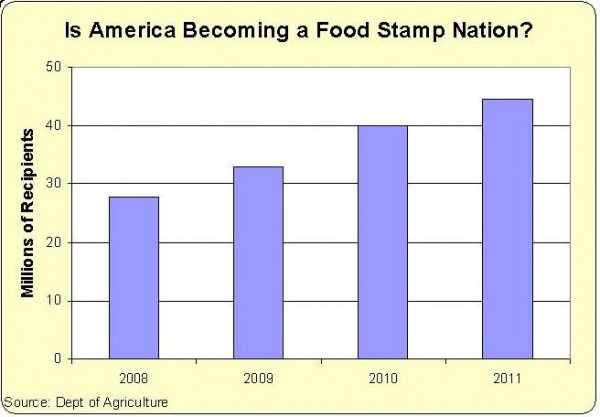I’ve beaten up on Newt Gingrich for his views on global warming and his attack on the Ryan budget plan, but I’m completely on his side in the faux controversy about whether it is racist to call Barack Obama the “food stamp president.”
This story from ABC News should worry everybody, regardless of whether the people getting trapped in government dependency are white, black, brown, yellow, or green with yellow polka dots.
Congress is under pressure to cut the rapidly rising costs of the federal government’s food stamps program at a time when a record number of Americans are relying on it. The House Appropriations Committee today will review the fiscal year 2012 appropriations bill for the Department of Agriculture that includes $71 billion for the agency’s “Supplemental Nutrition Assistance Program.” That’s $2 billion less than what President Obama requested but a 9 percent increase from 2011, which, critics say, is too large given the sizeable budget deficit. A record number of Americans — about 14 percent — now rely on the federal government’s food stamps program and its rapid expansion in recent years has become a politically explosive topic. More than 44.5 million Americans received SNAP benefits in March, an 11 percent increase from one year ago and nearly 61 percent higher than the same time four years ago.
Most people focus on the huge burden that the food stamp program imposes on taxpayers, which surely is significant, but there is another economic cost that is equally worrisome, and it applies to all income redistribution programs. Whenever the government gives people money simply because their incomes are below a certain level, that creates a poverty trap. More specifically, because people lose benefits for earning more income, they are penalized with very onerous implicit marginal tax rates for climbing the economic ladder.
This isn’t intuitive, so here’s a back-of-the-envelope hypothetical example. Let’s assume you are a low-income person who wants a better life and you have a chance to earn an additional $1,000. How much better off will you be, and will it be worth the costs you might incur (non-pecuniary costs such as the loss of leisure and pecuniary costs such as commuting and child care)?
To answer that question, let’s assume your official tax burden on that additional income is 10 percent for federal income tax, 15 percent for payroll tax, and 5 percent for state income tax. You may not even be aware of the employer portion of the payroll tax, so let’s drop that to 7.5 percent (actually 7.65 percent, but let’s keep this simple). And while state taxes are deductible, the vast majority of people with modest incomes don’t utilize itemized deductions. So the marginal tax rate on this additional income, depending on what assumptions you want to make, is between 20 percent and 25 percent.
So if you earn an additional $1,000, your disposable income only increases by about $750-$800. Is that worth it? Maybe, but maybe not, depending on the costs you incur to earn that income. In any event, the marginal tax rate is rather steep for a low-income person, you may be thinking.
But it gets worse. Let’s say that you lose $15 of government handouts for every $100 of additional income your earn. So when you earn $1,000 of income, you only keep $750-$800, but you also have to give up $150 of goodies from the government – meaning your effective disposable income only rises by $600-$650.
This means that your implicit marginal tax rate on earning more money is actually somewhere between 35 percent and 40 percent. In other words, your marginal tax rate is at least as high as the tax rate on rock stars and professional athletes.
Here’s a chart showing the number of food stamp recipients. It certainly looks like America is becoming a food stamp nation. But if want to see an even more disturbing image, look at the second chart in this article from the Mises Institute. You’ll see that my hypothetical example dramatically understates the marginal tax rate on people trying to join the middle class. As a taxpayer, I don’t like the cost of the food stamp program. As an economist, I hate the high marginal tax rates caused by income redistribution programs.


